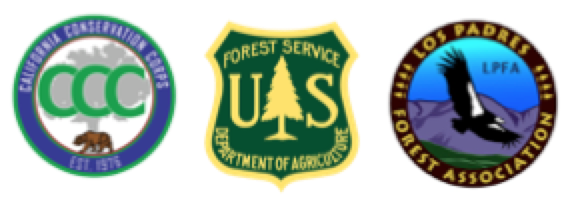 CCC Mono-Alamar Trail: Caracole Section
CCC Mono-Alamar Trail: Caracole Section
April 18 – May 4, 2016

CCC Headed Home After a Long Day Working Trail
Trail Organizations: Los Padres Forest Association, California Conservation Corps
Volunteers: Otis Calef, Richard Waller, Ed Fuentes, Kathleen Phelps, Rik Christensen, Don Jack, Bryan Conant
Trail Miles Worked: 2.86 miles
Camps & Trails Surveyed: Pie Canyon Jeepway, P-Bar Campground, Mono-Alamar Trail, Upper Mono Camp, Caracole Camp, Alamar Trail, Poplar Trail
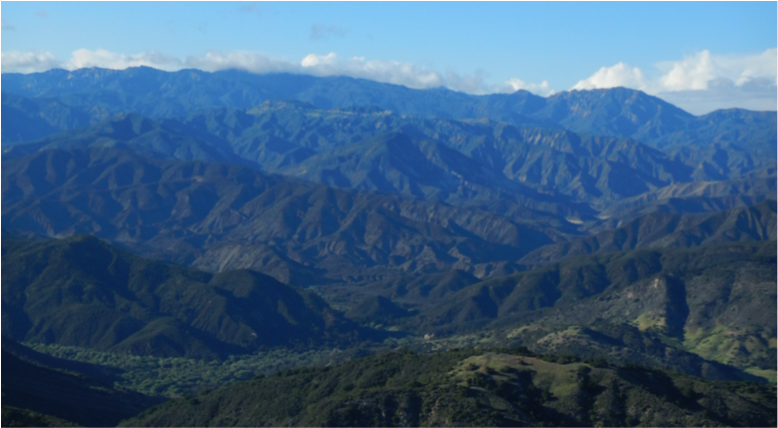
Mono Drainage
Project Description: The LPFA setup, supported and managed what ended up being a two-week California Conservation Corps (CCC) project along the Caracole section of the Mono-Alamar Trail and lower portions of the Poplar and Alamar Trails. These sections of trail were some of the hardest hit by the Zaca Fire and were in horrible shape. The LPFA spent a two days flagging the trail ahead of time so that the CCC would have a route to follow, otherwise it would have been nearly impossible to determine where the trail went. The CCC completed much of the trail to standard but focused primarily on opening up the trail corridor and treading along the steeper and sketchier sections of trail. All in all it was a very successful project along a harsh, remote and overgrown section of the Los Padres Forest. The entire Mono-Alamar Trail is now stock passable.
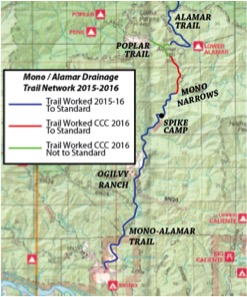
Project Accomplishments: As part of the RIRI Zaca Restoration program, the LPFA put together a plan to restore the Mono-Alamar Trail. The Mono-Alamar was damaged in the 2007 Zaca Fire and had not received any substantial trail work since then. It had been flagged a few times but remained more of a route than a trail. The proper trail was unfindable for most of the route and as a result hikers were basically taking the path of least resistance and following the creek. The first step in the restoration of Mono-Alamar was two successful projects in Fall 2015 clearing the trail from the Mono-Alamar Trailhead to the Mono Narrows. The third scheduled project was to spike a CCC crew 1.75miles above Ogilvy Ranch and have them work the Caracole section of the Mono-Alamar Trail, which goes from Mono Narrows up to Loma Pelona and Alamar Hill. Here is the link to the pre-project photos and instructions for the CCC:
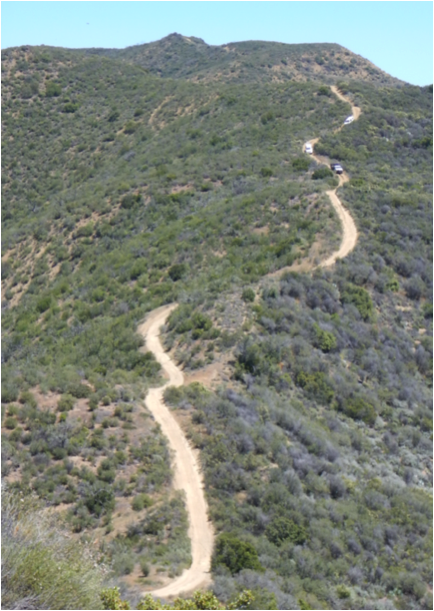
Steep Going, Pie Cyn Jeepway
After hours of logistical planning, we were ready to get started. First we had to get the packers out to Ogilvy Ranch, which would be the base of operations for the CCC spike. We met the packers (Kathleen Phelps, Ed Fuentes & Otis Calef) at the Mono-Alamar trailhead on the morning of April 18 and then after getting them set-off, met the CCC at P-Bar Campground. The CCC initially sent out a three-person team on April 18 to get the spike camp setup before the main crew arrived on the 19th. After meeting at P-Bar, we drove the hour over the 4×4 Pie Canyon Jeepway before eventually getting to Ogilvy Ranch. Once at Ogilvy Ranch we rendezvoused with the packers and took a load up to the spike camp, which was 1.75miles above the Ogilvy Adobe. The CCC team stayed at the spike camp while the packers returned to Ogilvy to camp at the upper Adobe. The next morning (4/19) the packers took a second load up to the spike camp while LPFA returned to P-Bar in order to meet the main CCC crew and escort them in to Ogilvy. Everything went as planned and the full CCC crew met the packers at Ogilvy in the early afternoon. The packers then took a third load that afternoon and after briefing the CCC crew leader on work expectations, the project was ready to roll. The next morning, the packers, the initial CCC team and LPFA left Ogilvy and returned to civilization. The CCC were supposed to be at the spike camp for 7 days.
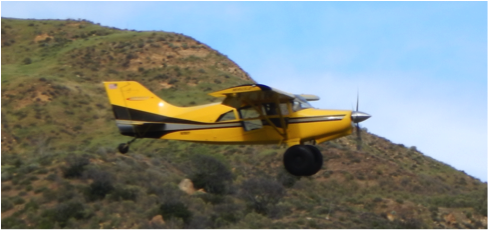
Ze Plane, Ze Plane
Two days later, the LPFA got a phone call from the CCC indicating that there was a mixup and that a cooler of luncheon meat was accidentally sent on a different CCC hitch and that they needed to get 50lbs of meat out to the Mono-Alamar spike camp. Rather than having the CCC spend over 8hrs driving to Ogilvy, we were able to find a Santa Ynez pilot named Doug who frequently flew into Ogilvy using their private landing strip. Doug happily volunteered to fly in a cooler of luncheon meat and after having the CCC drop off the cooler at the Santa Ynez Airport, Doug flew in later that afternoon and dropped off the cooler next to the airstrip. He buzzed the CCC spike camp in order to give them a literal heads up that the food had been delivered.
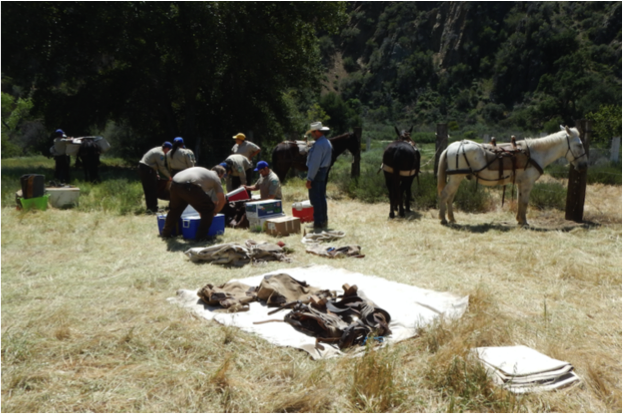
Packing CCC at Ogilvy
Two days after that we received phone calls from both the CCC spike crew leader and CCC staff in SLO that there was a substantial wind storm at the spike camp and that the crew was unable to work due to high winds estimated at 60mph. They were unable to walk or negotiate creek crossings due to the high wind. After consulting with CCC staff we made the decision to evacuate the spike crew and get them out of the Mono. The crew broke down half of their camp, buried whatever food they could and returned that evening to the Ogilvy Adobe camp. The next day the CCC staff from SLO drove back to Ogilvy and were able to get the crew out of the backcountry. By Sunday April 23 the spike camp was abandoned and all work had stopped.
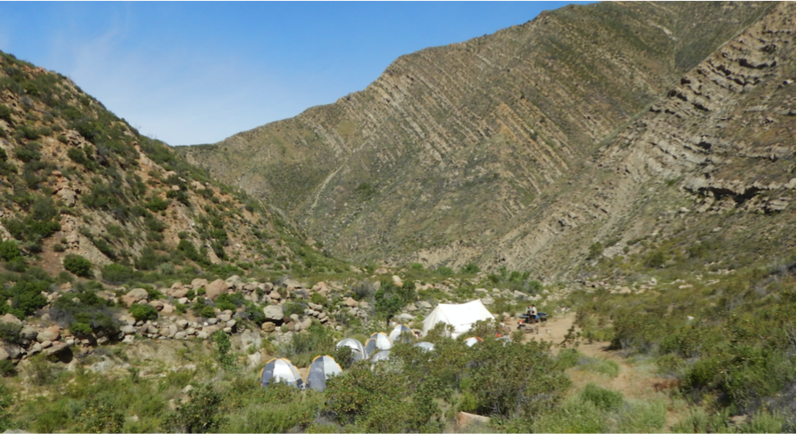
CCC Spike Camp
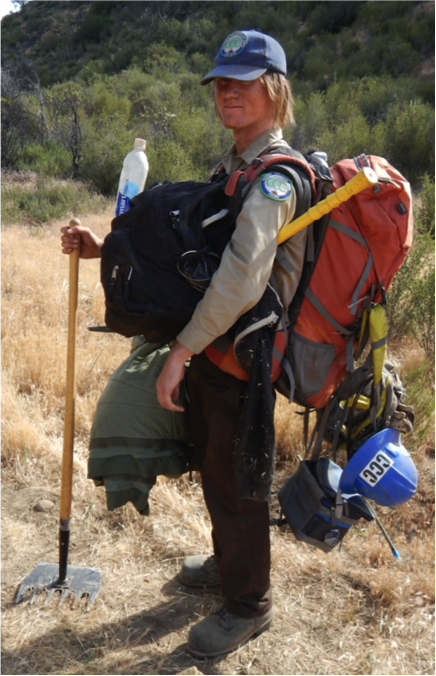
Plymale, Going Ultralite
Starting the next day, the LPFA and CCC got to work trying to figure out how to proceed with the project. We put together an plan that a smaller Santa Maria based CCC crew would head back in to the Mono spike camp that next Wednesday and pick up the work where the first SLO based crew left off. A smaller CCC crew arrived on Tuesday 4/26 and once again hiked up to the spike camp to ascertain the damage from the windstorm, unearth the buried food and setup the camp. On Wednesday 4/27 it was deja vu all over again as the packers met at the Mono-Alamar Trailhead (this time Otis Calef, Richard Waller and Rik Christensen) and after getting them set off, LPFA returned to P-Bar to meet the Santa Maria CCC crew and usher them out to Ogilvy. We once again met at the upper Ogilvy Adobe and took in one load that afternoon up to the spike camp. After once again briefing the crew leader on expectations, we packed a load of trash back to Ogilvy and settled in for the night. The next morning the packers took a final load up to the spike camp and returned along with LPFA back to the trucks and out to civilization.
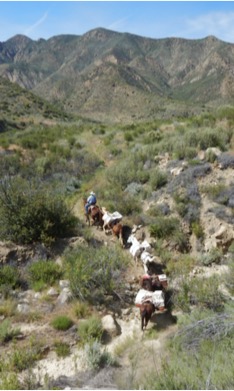
The Otis Pack Train
Now all the drama was done for the project* and the crews could focus on what they do best: clearing the trails. Between the two crews and over two weeks on the project they were able to work on the trail 8 days. The goal for the week was to clear 2.86miles of trail to standard from Mono-Narrows up to the junction of the Alamar / Mono-Alamar / Poplar Trails and then work the Poplar Trail up to the bottom of Loma Pelona and work the Alamar Trail to the top of Alamar Hill. The work was completed to standard over the first 1.5miles above Mono Narrows along the Mono-Alamar Trail and the rest of the trail was cleared but does require additional tread work in order to get to standard. The crew made the correct decision to get the entire 2.86miles of trail open rather than to only get a portion of that completed to standard. It was the correct decision. Fortunately, they were able to complete the worst section of trail called the Caracole, which is a series of winding switchbacks that climb steeply out of Mono Creek with quite a few sheer drop-offs along the way. This section was certainly not passable to stock and borderline passable for foot traffic. At the completion of the project, both Otis and Ed Fuentes were able to get their mules all the way along the 2.86miles of trail.
On Tuesday May 3 we once again met the packers (Otis Calef, Don Jack & Ed Fuentes) at the Mono-Alamar Trailhead, drove in to the Ogilvy Adobe and began a two-day, 3 load extraction of the CCC crew. All went well enough as we were able to cleanup the spike camp, get the crew out and return over the mountain to civilization once again. Quite a few twists and turns for a one-week hitch, but at the end of the project we were happy with the work completed and the Mono-Alamar Trail can be safely hiked or ridden once again.
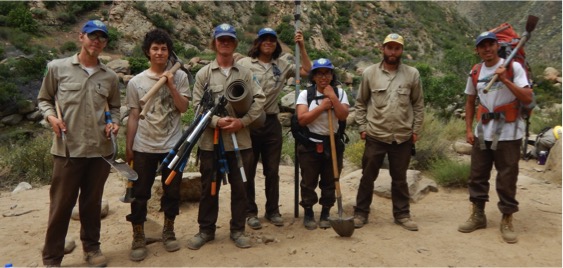
CCC Trail Crew
ADDITIONAL PHOTOS
Mono-Alamar Trail: https://goo.gl/photos/o3XDYMDpYh2TPR149
Alamar & Poplar Trail: https://goo.gl/photos/ud36DVZVDxrtkHrS9
Project Notes:
- There was plenty of water for the CCC crew although we did see it starting to dry up between when we started and when the hitch was completed.
- The CCC saw one other hiking group during their two combined weeks on the Mono.
- We did fix and replace a broken trail sign post on the Ogilvy property.
- We also did a little trail work along the Ogilvy bypass section of the Mono-Alamar.
Future Projects Needed:
- We’ll need to send in another crew to complete the work along the upper 1/2mile of the Mono-Alamar and then the section of Alamar Trail up to Alamar Hill and the section of Poplar Trail up to the Lomas.
- Most of that work will be grubbing out rootballs within the tread, water control structure creation and light brushing.
- There is one large downed sycamore near Caracole Camp that the CCC could not cut with their 18” chainsaw bar. We should send in a crosscut crew or a larger saw to remove that tree.
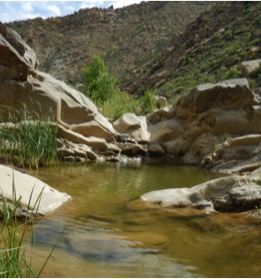
Spike Camp Pool